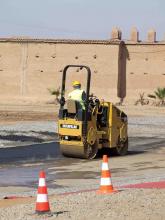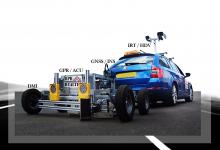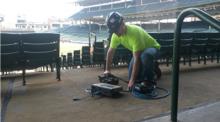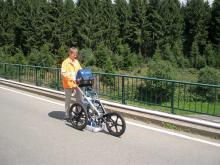Tens of thousands of bridges in the United States are in desperate need of repair. But where to begin analysing their deteriorating state? Roger Roberts* investigates tips and techniques for ensuring bridge safety
The average age of America’s more than 600,000 crumbling bridges is 42 years – many are 60 to 80 years old. The situation is dire, with many described as functionally obsolete, according to the American Society of Civil Engineers’ latest edition of its Report Card for America’s Infrastructure.
More new bridges, or just better maintenance of old ones?
Tens of thousands of bridges in the United States are in desperate need of repair. But where to begin analysing their deteriorating state? Roger Roberts* investigates tips and techniques for ensuring bridge safety
The average age of America’s more than 600,000 crumbling bridges is 42 years – many are 60 to 80 years old. The situation is dire, with many described as functionally obsolete, according to the2600 American Society of Civil Engineers’ latest edition of its Report Card for America’s Infrastructure.
The cost to put this right is high, the report notes. Federal, state and local governments will have to stump up US$8 billion annually for years to come to either repair or replace the infrastructure.
But how do authorities prioritise bridge work? Inspections are a first step in the process, but there are many methods to choose from. Understanding the extent of their usefulness is essential for all organisations.
Inspection methods are divided between destructive methods, like coring and chipping, and non-destructive testing techniques – those that evaluate the properties of a material, component or system without causing damage. The goal is to detect delamination of a coating from a substrate or the splitting of a structure into layers. Delamination, which is caused by the corrosion of reinforcing steel through repeated freezing and thawing, is often detected only by non-destructive acoustical tests, including hammer sounding or chain dragging.
This low-tech method is basically a chain drag or a hammer moved over the surface of the bridge while the worker listens for a change in tone or pitch made by the dragged instrument. Such methods are inexpensive and can be done by someone with limited training. The worker marks the area with a circle of spray paint and another employee takes a picture or lays out a grid to map the spots considered suspect.
Acoustical methods also don’t work on bridges with asphalt overlays. Then there is the human factor. People have different degrees of hearing and other noise, such as traffic, can affect people’s hearing. This makes the method somewhat unreliable, an inexact way to determine deterioration. It’s nearly impossible to get repeatable results using two operatives investigating the same piece of bridge deck.
And do not forget, the worker is hearing the result of delamination because the rebar is significantly corroded. What will not be detected are areas where corrosion is well advanced but not yet at the delamination stage, making the method inappropriate for planning proactive maintenance.
A more sophisticated method, the half-cell potential technique, assesses rebar corrosion by measuring the voltage between the rebar in the concrete and a reference electrode placed on the surface of the concrete. Because this approach is more sensitive to rebar corrosion than acoustical sounding, it detects corrosion before delamination has happened.
Unfortunately, half-cell potential cannot be used on bridges with asphalt overlays. Bare concrete is required. The method also requires closing the bridge and workers need more time to complete the process because measurements are done following a grid pattern over the bridge deck. The method is best for when you know deck repairs are required but you aren’t sure exactly where they are needed and what kind of repairs are necessary. The method helps determine if a deck needs to be completely removed or whether in-place cut-and-patch repairs will suffice.
The infrared method relies on changes in infrared radiation from the surface of concrete to indicate corrosion. This can be done by mounting the equipment on a vehicle to get the job done quickly and having less bridge downtime. However, the infrared technique has to be done when there is a big difference between the temperature of the bridge surface and the ambient air. Also, it cannot be done on bridges with asphalt overlays.
Visual inspection is, as its name implies, a low-tech method for mapping cracks, spalling and potholes. It pinpoints only apparent damage and it certainly won’t tell you the condition of the concrete’s interior. In this way, it tells you only the obvious.
The most technically sophisticated non-destructive testing methods use ground-penetrating radar (GPR) which involves radar pulses to get an image of the subsurface. Generally speaking, GPR can be used in rock, soil, ice, fresh water, pavements and other structures. The technique uses electromagnetic radiation in the microwave band -- UHF/VHF frequencies – that are bounced back from subsurface structures. The reflected signals detect objects, changes in material, voids and cracks. Unlike other testing methods, GPR can be used for testing asphalt as well as concrete highway surfaces and bridge decks.
The two most common types of GPR for bridge surface measurement are ground-coupled and air-launched. Ground-coupled systems rely upon an antenna placed very close to the road surface while air-launched systems use directional antennas aimed at the surface from a height of around 30cm to 50cm.
Ground-coupled GPR systems are typically mounted on a cart pushed by a worker or it can be loaded onto a vehicle traveling about 8kph. This includes the antenna and a controller. The radar looks for weakness in the returning radar signal from the reinforcing steel; the weaker the signal, the more deterioration. This technique shows the location and depth of rebar, tie bars and dowel bars.
Because ground-coupled antennas are so close to the object’s surface, there is less likelihood of radio frequency interference from emitters such as mobile phone masts and TV broadcasting towers. But because they are so close to the object’s surface, the equipment cannot be moved along too fast and typically is rolled along at below normal highway speeds. Air-launched antennas, though, can be moved along at speeds of up to 105kph and still get good readings.
There are a number of advantages of GPR technology, such as being well suited for prioitising work for budgetary purposes. Whereas acoustical methods are very subjective, GPR data is quantitative.
No matter what non-destructive testing method is used, a certain amount of coring, the drilling of a hole to view the concrete and rebar condition, and chipping, literally chipping away to view the rebar, may be needed to back the deterioration map. It’s a confidence boost knowing your testing method has worked, but core samples can also measure the mechanical properties of the concrete – the compressive and shear strength. All this is useful information beyond what the non-destructive methods provide.
However, aside from being destructive, obtaining each core can be expensive. So the goal is to minimise the number of cores yet still give the agency confidence that their results are correct. Condition assessments can be made using both air-launched horn antenna and ground-coupled antenna.
Ground-coupled antenna provide better horizontal resolution that enables imaging of individual rebars in the top mat, usually not possible with horn antenna. This is why ground-coupled antennas provide higher quality data than air-launched antenna. Ground-coupled antenna collect densely spaced measurements along lines that cross over the top rebar in the upper mat at right angles, or close to a right angle if the rebars are skewed.
The amplitude of the radar wave reflection from each rebar is recorded in relation to its location on the bridge. Relative changes in the rebar reflection amplitudes indicate the condition of the rebar and the concrete above it. For maximum accuracy, reflections from rebars at different depths may need to be corrected depending on the depth difference. This can be tricky because variation in concrete moisture can give the illusion of depth variation. Also, there are rules of thumb to picking the relative change in rebar reflection that indicates deterioration is enough to warrant repairs.
Often the worker will map surface defects and do a visual inspection of staining on the underside of the bridge deck to get a more all-rounded picture of possible deterioration. GPR can also be used for quality assurance and quality control of a new bridge deck to measure whether the depth of the rebar and thickness of the concrete are up to specification.
Concrete cover measurements are most often done during quality assurance checks on the bridge deck after the concrete has been poured to ensure the top rebar mat is at the depth specified in the bridge plans. The measurements involve collecting data with a ground-coupled antenna along one or more profile lines to record the arrival time of the rebar reflections.
A core is then drilled at one of the rebar locations to measure the rebar depth. This is inputted into software to calculate the radar wave velocity. This information is then used to note very accurate rebar depths. The user should pick a rebar near the beginning or end of the profile line for the calibration core to ensure that the rebar depth can be matched up with the same rebar that generated the reflection detected in the GPR data.
One example of GPR technology is GSSI’s BridgeScan, a complete system for collecting, processing and interpreting GPR data for assessing bridge deck condition. The procedure provides a map of rebar reflection amplitudes. Areas with the lowest rebar reflection amplitudes correspond to that portion of the bridge deck containing concrete deterioration and possible rebar corrosion.
An ASTM standard is used to assess the range of reflection amplitudes that correspond to expected bridge maintenance. Assessment of maintenance requirements indicated by the GPR data is backed up with visual inspection and other condition information, such as maintenance records.
*Roger Roberts is a research engineer with GSSI, Geophysical Survey Systems, Inc., a US manufacturer of ground penetrating radar and electromagnetic induction.
The average age of America’s more than 600,000 crumbling bridges is 42 years – many are 60 to 80 years old. The situation is dire, with many described as functionally obsolete, according to the
The cost to put this right is high, the report notes. Federal, state and local governments will have to stump up US$8 billion annually for years to come to either repair or replace the infrastructure.
But how do authorities prioritise bridge work? Inspections are a first step in the process, but there are many methods to choose from. Understanding the extent of their usefulness is essential for all organisations.
Inspection methods are divided between destructive methods, like coring and chipping, and non-destructive testing techniques – those that evaluate the properties of a material, component or system without causing damage. The goal is to detect delamination of a coating from a substrate or the splitting of a structure into layers. Delamination, which is caused by the corrosion of reinforcing steel through repeated freezing and thawing, is often detected only by non-destructive acoustical tests, including hammer sounding or chain dragging.
This low-tech method is basically a chain drag or a hammer moved over the surface of the bridge while the worker listens for a change in tone or pitch made by the dragged instrument. Such methods are inexpensive and can be done by someone with limited training. The worker marks the area with a circle of spray paint and another employee takes a picture or lays out a grid to map the spots considered suspect.
Acoustical methods also don’t work on bridges with asphalt overlays. Then there is the human factor. People have different degrees of hearing and other noise, such as traffic, can affect people’s hearing. This makes the method somewhat unreliable, an inexact way to determine deterioration. It’s nearly impossible to get repeatable results using two operatives investigating the same piece of bridge deck.
And do not forget, the worker is hearing the result of delamination because the rebar is significantly corroded. What will not be detected are areas where corrosion is well advanced but not yet at the delamination stage, making the method inappropriate for planning proactive maintenance.
A more sophisticated method, the half-cell potential technique, assesses rebar corrosion by measuring the voltage between the rebar in the concrete and a reference electrode placed on the surface of the concrete. Because this approach is more sensitive to rebar corrosion than acoustical sounding, it detects corrosion before delamination has happened.
Unfortunately, half-cell potential cannot be used on bridges with asphalt overlays. Bare concrete is required. The method also requires closing the bridge and workers need more time to complete the process because measurements are done following a grid pattern over the bridge deck. The method is best for when you know deck repairs are required but you aren’t sure exactly where they are needed and what kind of repairs are necessary. The method helps determine if a deck needs to be completely removed or whether in-place cut-and-patch repairs will suffice.
The infrared method relies on changes in infrared radiation from the surface of concrete to indicate corrosion. This can be done by mounting the equipment on a vehicle to get the job done quickly and having less bridge downtime. However, the infrared technique has to be done when there is a big difference between the temperature of the bridge surface and the ambient air. Also, it cannot be done on bridges with asphalt overlays.
Visual inspection is, as its name implies, a low-tech method for mapping cracks, spalling and potholes. It pinpoints only apparent damage and it certainly won’t tell you the condition of the concrete’s interior. In this way, it tells you only the obvious.
The most technically sophisticated non-destructive testing methods use ground-penetrating radar (GPR) which involves radar pulses to get an image of the subsurface. Generally speaking, GPR can be used in rock, soil, ice, fresh water, pavements and other structures. The technique uses electromagnetic radiation in the microwave band -- UHF/VHF frequencies – that are bounced back from subsurface structures. The reflected signals detect objects, changes in material, voids and cracks. Unlike other testing methods, GPR can be used for testing asphalt as well as concrete highway surfaces and bridge decks.
The two most common types of GPR for bridge surface measurement are ground-coupled and air-launched. Ground-coupled systems rely upon an antenna placed very close to the road surface while air-launched systems use directional antennas aimed at the surface from a height of around 30cm to 50cm.
Ground-coupled GPR systems are typically mounted on a cart pushed by a worker or it can be loaded onto a vehicle traveling about 8kph. This includes the antenna and a controller. The radar looks for weakness in the returning radar signal from the reinforcing steel; the weaker the signal, the more deterioration. This technique shows the location and depth of rebar, tie bars and dowel bars.
Because ground-coupled antennas are so close to the object’s surface, there is less likelihood of radio frequency interference from emitters such as mobile phone masts and TV broadcasting towers. But because they are so close to the object’s surface, the equipment cannot be moved along too fast and typically is rolled along at below normal highway speeds. Air-launched antennas, though, can be moved along at speeds of up to 105kph and still get good readings.
There are a number of advantages of GPR technology, such as being well suited for prioitising work for budgetary purposes. Whereas acoustical methods are very subjective, GPR data is quantitative.
No matter what non-destructive testing method is used, a certain amount of coring, the drilling of a hole to view the concrete and rebar condition, and chipping, literally chipping away to view the rebar, may be needed to back the deterioration map. It’s a confidence boost knowing your testing method has worked, but core samples can also measure the mechanical properties of the concrete – the compressive and shear strength. All this is useful information beyond what the non-destructive methods provide.
However, aside from being destructive, obtaining each core can be expensive. So the goal is to minimise the number of cores yet still give the agency confidence that their results are correct. Condition assessments can be made using both air-launched horn antenna and ground-coupled antenna.
Ground-coupled antenna provide better horizontal resolution that enables imaging of individual rebars in the top mat, usually not possible with horn antenna. This is why ground-coupled antennas provide higher quality data than air-launched antenna. Ground-coupled antenna collect densely spaced measurements along lines that cross over the top rebar in the upper mat at right angles, or close to a right angle if the rebars are skewed.
The amplitude of the radar wave reflection from each rebar is recorded in relation to its location on the bridge. Relative changes in the rebar reflection amplitudes indicate the condition of the rebar and the concrete above it. For maximum accuracy, reflections from rebars at different depths may need to be corrected depending on the depth difference. This can be tricky because variation in concrete moisture can give the illusion of depth variation. Also, there are rules of thumb to picking the relative change in rebar reflection that indicates deterioration is enough to warrant repairs.
Often the worker will map surface defects and do a visual inspection of staining on the underside of the bridge deck to get a more all-rounded picture of possible deterioration. GPR can also be used for quality assurance and quality control of a new bridge deck to measure whether the depth of the rebar and thickness of the concrete are up to specification.
Concrete cover measurements are most often done during quality assurance checks on the bridge deck after the concrete has been poured to ensure the top rebar mat is at the depth specified in the bridge plans. The measurements involve collecting data with a ground-coupled antenna along one or more profile lines to record the arrival time of the rebar reflections.
A core is then drilled at one of the rebar locations to measure the rebar depth. This is inputted into software to calculate the radar wave velocity. This information is then used to note very accurate rebar depths. The user should pick a rebar near the beginning or end of the profile line for the calibration core to ensure that the rebar depth can be matched up with the same rebar that generated the reflection detected in the GPR data.
One example of GPR technology is GSSI’s BridgeScan, a complete system for collecting, processing and interpreting GPR data for assessing bridge deck condition. The procedure provides a map of rebar reflection amplitudes. Areas with the lowest rebar reflection amplitudes correspond to that portion of the bridge deck containing concrete deterioration and possible rebar corrosion.
An ASTM standard is used to assess the range of reflection amplitudes that correspond to expected bridge maintenance. Assessment of maintenance requirements indicated by the GPR data is backed up with visual inspection and other condition information, such as maintenance records.
*Roger Roberts is a research engineer with GSSI, Geophysical Survey Systems, Inc., a US manufacturer of ground penetrating radar and electromagnetic induction.










